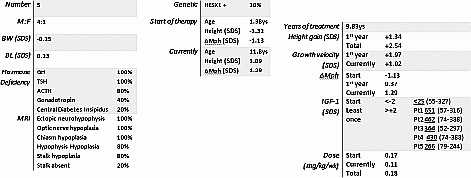ESPE2016 Poster Presentations Growth P2 (47 abstracts)
Septo-Optic Dysplasia and Excellent Growth with Low Growth Hormone Dose: Our Experience
Gabriella Cinzia Pozzobon , Gemma Marinella , Chiara Damia , Cristina Partenope , Dario Gallo , Roberta Pajno , Sara Osimani & Giovanna Weber
San Raffaele Hospital, Milan, Lombardy, Italy
Background: Septo-optic dysplasia (SOD) is a congenital, rare anomaly (1:10 000) associated with optic nerve hypoplasia, midline brain abnormalities and pituitary hormone abnormalities. Genetic alterations associated are: HESX1, SOX2 and SOX3. SOD’s pattern of growth even without GH treatment has been reported to be often good.
Objective and hypotheses: Evaluate SOD’s growth in patients followed in our Centre.
Method: See Figure 1.
Results: All presented severe GH deficiency with low IGF1 levels, hypoglycemia and pathological MRI, therefore started GH treatment before 3 years of age. During GH treatment growth rate was excellent with a starting GH dose of 0.18 mg/kg per week. As IGF1 levels were >+2 SDS in each patients at least once, GH posology was reduced to a median of 0.11 mg/kg per week with a normalization of IGF1 levels, nevertheless growth velocity remained good (gv: +1.02 SDS), with a currently median height gain of +2.54 SDS and a median delta to midparental height of +1.29 SDS after almost 10 years of treatment.
Conclusion: Some SOD, with GH and IGF1 deficiency, present excellent growth during GH treatment even with minimal doses. The mechanism underlying is not clear: high levels of insulin, PRL or leptin may be involved, however no specific cause has been found, therefore more studies are needed to better explain this phenomenon.

Figure 1
 }
}



